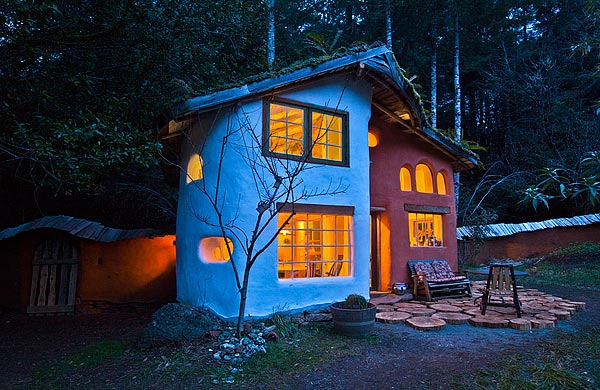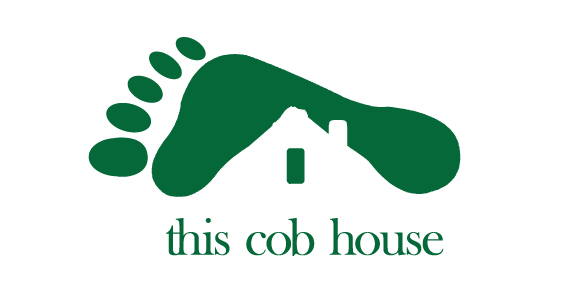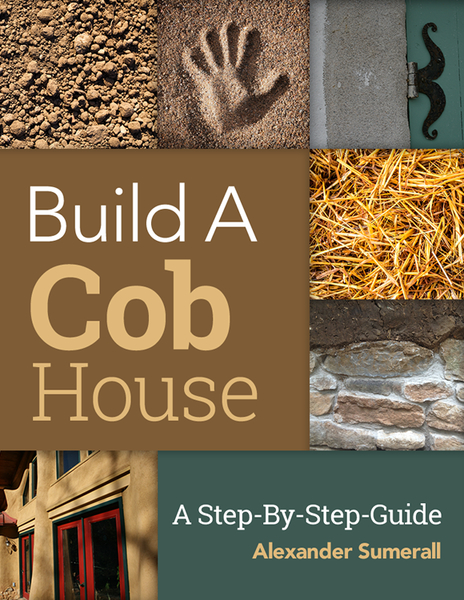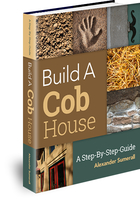
When people first learn about building homes and structures out of cob they get really excited and their imaginations go wild with creative ideas and all the possibilities that the material offers for creating things.
Then at some point in our excitement we get a rude awakening to the thought of how we might actually go about building a cob building in our bureaucratic, twisted society. We tend to worry about how we’ll make it past all the laws, regulations, and building codes required to build according to our own imaginations. Not to mention the expensive inspections!
In the United States, we follow the International Building Code. This is supposed to be here to safeguard us from dangerous and risky construction methods. While it’s not totally useless and offers some true benefits, it is narrow minded in its scope and hinders creative ideas and innovation. David Eisenberg further explains and expands on the narrow minded thought patterns of building officials and how following the IBC can actually backfire on our safety.
The fact is that our current scale system is flawed, behind the microscopic codes money has become the ultimate measure for everything. Innovation is constrained by currencies and not lives.
According to the International Code Council (ICC), the purpose of the International Building Code is to “safeguard public health, safety and general welfare… from hazards attributed to the built environment.”
But take it for what you will. As Cob Builders and Natural Builders we have to take the Orwellian-like system into account at some point. It might seem daunting to face but there is actually hope!
Cob Building Codes and How to Get a Permit to Build
It is not specified in the building code whether or not building with cob is illegal or not. For many people, they have first been required to get a permit to build with cob. They have had to hire an engineer to help develop their building plans. Once cob designs are approved by a “licensed design professional”, the building department will usually give you approval and permit you to build. Just be ready to fork over some mad cash in the process!
What Other Options Do I Have? Easier Ones Please…
I asked Mike McDonough, an experienced Cob Builder who apprenticed with the Cob Cottage Company, what his thoughts were on cob building codes and regulations. Here’s what he said in a nutshell:
There are no codes for cob in the US, there may be in places like England, I’m not sure. There is a code for adobe in New Mexico, and strawbale in California, although these are clearly different systems. Most codes in the US follow the International Building Code (IBC). Each state has their slight variation of it, as do counties and major cities. However, because there is no code for cob doesn’t mean that it can’t be built with legally. It really comes down to the people in the local building department, how they interpret the code, and doing what it takes to satisfy their concerns with an unfamiliar material. This can mean having the building engineered or stamped by an architect, which removes the building department’s liability in case of failure.
Here’s the real kicker!
There are cases in which you don’t need to get a permit for a building at all, and can just build what you want to. This is common in rural counties (except in the northeast, California, probably other places as well), and for buildings under a certain size footprint, usually 12×12 (if it has no utilities).
So in some cases you do not even need a permit and are free to build as you please. I have personally never had any interest in building cob structures in a city or suburban area. I only want to build out in the rural countryside. That’s just my preference, but if you share that feeling then you have much less to worry about.
Otherwise there are permit exemptions if you build: under a certain size, for agriculture or storage use, or build in a rural area that does not require a permit.
Light at the End of the Tunnel
Don’t let the thought of codes and regulations get you down. Keep pushing the boundaries and creating and innovate. Some people might look at us as crazy for what we do, but we’re on the cutting edge here. It’s to be expected.
The future of building belongs to us. We need to keep networking and educating people on the advantages of natural building methods like cob. Sooner or later, more people will wake up to the reasons why we use the methods of building that we do.
As people realize the need, we could get building codes enacted for cob and not have to worry about this issue anymore.




So, does 12 x 12 imply interior footprint? or exterior? or roof line? cob is very thick so this is an important distinction.
The International Building Code clearly states that a “shed or playhouse” under 120 square feet in interior dimensions is exempt from any permits. This is an important provision to draw attention to.
According to Ianto Evans, building departments usually have a minimum size limit below which no permit is required. Sometimes it’s as low as 100 square feet, but is generally 120 or 200 square feet. It’s best to check with your local building department to double check so they don’t bring up a dispute later on.
Some departments do define square footage by roof area too. Another reason to just check with the department first.
Hope that helps!
Alex.
People should come to Iowa. In the country where it is heaveily wooded we have hills, clay and few building restrictions. As long as you are building it on your own property and for yourself.
Also, if you want to learn more about building codes in the alternative building field then I would really recommend watching the documentary called “Garbage Warrior.” You can watch the whole hour and a half video on Youtube here: http://www.youtube.com/watch?v=YrMJwIedrWU
I am soon to be a first time land buyer. I want to build a cob home on the land. It is in rural (very rural as in no stores or businesses of any type for miles and miles), Milo, Oklahoma in Carter County and I am not sure how to go about to finding what codes there are, or if there are any. Where would I look? Who would I ask? I have been trying to find the answer by googleing it and it just leads to blogs.
hi janis
i live in oklahoma and have just recently stumbled upon this “cob” idea. I was wondering if you have had any success with cutting through red tape or any legalities. Oklahoma can often be pretty laid back so i was thinking that if i purchased some land as you were mentioning and just built it then you normally become what many oklahomans call “grandfathered-in”
I have inquired through both Murray County and Carter County Courthouses in Oklahoma and found that as long as you build outside of city limits there are no building codes. You do not have to have permits to build ANYTHING! In fact they told me that they didn’t care what was built as long as it was outside of city limits. That includes electric, plumbing and all.
I live in oklahoma. Just wanted to see if you were successful in building your home without interference. I would also like to know if you did receive resistance, what were your obstacles. Thanks
Does anyone know about Nevada? I want to buy land in Lyon county and build cob. I’m hoping 1200 sq ft 2 story. Where do I start with codes? It snows here. Ideas? And can we build an old fashion open fireplace in the house? Thank you
I to am thinking of building in Oklahoma. Haven’t purchased land yet- I’m in the very beginning stages. any assistance/advice would be greatly appreciated!
I am Anxious to see how =your plans are going!!
Check the county’s homepage. It should have a link to a building permits office and you can talk to them. Also call the Township clerk. For example, some townships in Michigan only require a land use permit, no building permit, for barns on farming land.
This blog was… how do I say it? Relevant!! Finally I have found something that helped me.
Kudos!
OR you can tell them to go chase bullocks and build what you want. Caving to statism is not a healthy way to live people.
Rebel Gal
While I sympathize with your feelings, the results of that approach can be heart-breaking. When I lived in the Florida panhandle, the powers-that-be forced someone to tear down a truly wonderful treehouse because it ‘didn’t conform to code’. Refusing would only get the owner jailed, and then they’d send in a bulldozer…NEVER go out of your way to offend petty bureaucrats; they’ll stay up night after night searching for some obscure statute that allows them to screw you over…
I agree with both. We should be able to build what we want when we want. If they want “safety” involved, then it should be free. Paid for by city county state federal taxes. I know a person has to make money, but if you can read how to do something, the same way the specialists learned how to do it, then the “inspector” should actually inspect and advise… not shut down or tear down. And if a person decides to not ask for or take the advise, no one is liable for that except that person. AND, government has too much power, and drag things on and on and on, for no good reason other than pettyness.REFORM of all levels of government desperately needed.